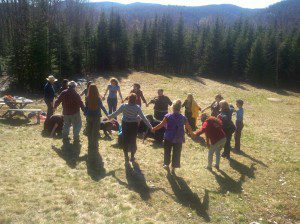
We dream for our communities as well as ourselves and we can learn to do this as a conscious practice in the service of peace and healing. By bringing dreams into the lives of people around us, we can heal and revitalize our family relations, our workplace, our schools, our healthcare and our communities.
We can agree to dream together on a common theme. Dream incubation may not yet be a standard resource in the workplace, or even on those retreats where company employees are urged to “think outside the box”, but it should be!
A corporate retreat was going nowhere until a facilitator who had attended my workshops persuaded the CEO to invite the executives to dream overnight on the main challenge facing the company. In the morning, the boss revealed that he himself had dreamed a creative solution, and the experience of dream-sharing livened and loosened up the group, making the retreat much more rewarding than might otherwise have been the case, and leading to longer-term organizational healing.
Here’s how to introduce the practice of dreaming on common issues to a group that may have little or no experience of working with dreams:
- Explain that you can “solve it in your sleep”. Give examples of how creative solutions to practical problems have come through dreams – for example, how a dream led to the invention of the sewing machine needle, or how Harriet Tubman used dreams and visions to guide 300 escaping slaves to freedom on the Underground Railroad.
- Formulate a group intention. Ask members of the group to come up with a common intention. “We would like guidance on such-and-such.” Agree that each member will write down that intention and focus on it before going to sleep.
- Get everyone to record something. Ask everyone to record whatever they remember when they wake up – even if it is a feeling or bodily sensation or passing thought rather than the memory of a dream experience. Emphasize that dream reports should not be edited or censored;we want the raw data!
- Record synchronicities as well as dreams. Ask everyone also to note any unusual incidents or observations from waking life in the period before the group meets again.
- Share with the group. Pool your dream reports and notes on synchronicity, and note how they relate to your theme. You may notice that some of the dreams may be asking you to go beyond your original question and re-vision the whole issue.
- Action plan. Come up with a group bumper sticker and an action plan. A wonderful way to honor community dreams, when your group is open to it, is to produce theater or performance from what has been shared; this can be wonderful fun, and brings through vital energy as well as guidance.
This article is partly adapted from Active Dreaming by Robert Moss. Published by New World Library.

